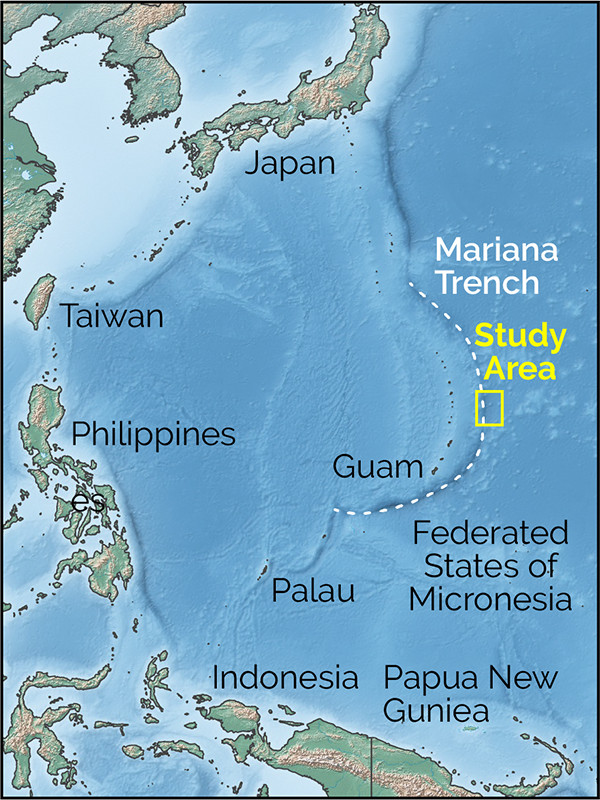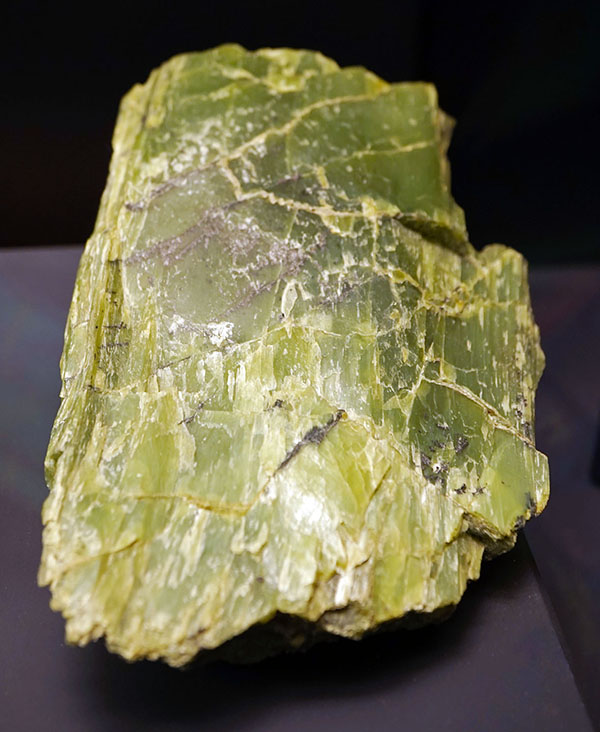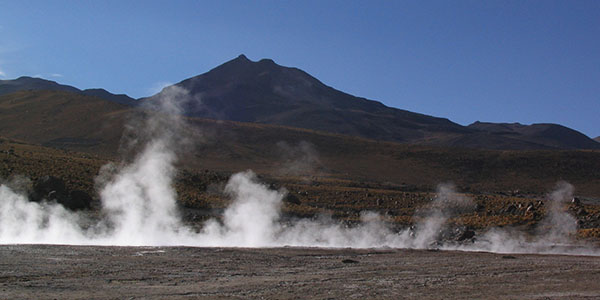
by Jerimiah Oetting Wednesday, January 30, 2019

A seismic study of part of the Pacific Plate diving beneath the Mariana Trench has revealed that old and cold subducting plates, like the Pacific, likely carry a lot more water into the mantle than previously realized. Credit: K. Cantner, AGI
For all the water stored in oceans, ice and other reservoirs at Earth’s surface, there’s likely even more in the planet’s interior, where it plays important roles in many geological processes, including the formation of magma and the lubrication of earthquake-producing fault zones. Uncovering just how much water is inside Earth — and the extent to which it moves back and forth between the surface and subsurface — has long been a challenge for scientists interested in understanding the planet’s water cycle. A new study peering beneath the Mariana Trench in the Western Pacific has revealed that some subduction zones might pull significantly more water into Earth’s interior than previously thought.
As subducting plates descend into oceanic trenches, they carry oceanic crust, upper mantle rock, and sediments deeper into Earth, as well as seawater entrained in minerals in these materials. Most prior studies of downgoing water in subduction zones have focused on plates that are relatively young and commensurately warm, researchers wrote in the new study, published in Nature. But the methods used to measure water content in these younger plates may not accurately account for water retained in minerals deep within older and colder slabs, they noted.
With older subducting plates, “because the [downgoing material] is cooler, it is more difficult for it to be heated up,” says Chen Cai, who led the study as part of his doctoral research at Washington University in St. Louis. “So, water can be withheld in older subducting slabs to deeper depths.”
The subducting edge of the Pacific Plate that dives beneath the Mariana Plate, forming the Mariana Trench, is very old as ocean crust goes — about 150 million years — suggesting it could be particularly water-rich, which is one reason why Cai and his colleagues chose to study it.
Serpentine-rich mud volcanoes that erupt on the seafloor above the subduction zone were another hint that a lot of water is subducted beneath the Mariana Trench. “Those mud volcanoes [are] formed by the reaction of mantle rocks with water,” Cai says. Serpentine is a hydrous mineral that forms as mantle minerals like olivine encounter water. The mineral is stable at the cooler temperatures of older slabs and can thus be transported deeper into the mantle at subduction zones than it can in warmer slabs. Eventually, when the pressure and temperature rise sufficiently, deep within the subduction zone, this serpentine begins to dehydrate, releasing water that makes its way back to the surface through volcanic activity.

Serpentine is a hydrous mineral that forms as other mantle minerals, like olivine, react with water. The mineral is stable at the cool temperatures of old subducting slabs, thus allowing water to be transported deep into the mantle. Credit: Tiia Monto, CC BY-SA 3.0
Scientists have known about this process for some time, but their ability to reliably see the depth that water, in the form of hydrous minerals like serpentine, reaches in the mantle has been hampered by the techniques they have used.
“Currently, most studies concerning [oceanic] subduction zones are conducted by active-source [seismic] methods,” Cai says. In active-source seismology, scientists produce artificial seismic waves with a large underwater air cannon, and then monitor the speeds at which the waves propagate through different materials to image the subsurface and learn about the composition of the deep rock, including whether hydrous minerals are present. The disadvantage with active-source methods, Cai says, is that they are unable to resolve structures deeper than about 10 kilometers beneath the seafloor.
“That’s not really a problem for [studying] young slabs, because they’re so hot the minerals in the slab can’t contain water,” says Doug Wiens, Cai’s graduate advisor at Washington University and a co-author of the study. “But old, cold plates, like the Pacific Plate going down into the Mariana Trench, can actually contain a lot of water.”
Rather than active-source techniques, the researchers turned to passive-source seismology, the method commonly used on land for detecting vibrations from earthquakes. After deploying 20 seismographs to the ocean bottom around the trench and seven land-based seismographs on nearby islands, the researchers collected seismic data for about a year.
The seismic velocities through the subduction zone that the team observed “were different from what we would normally expect in the Pacific Plate,” Wiens says. The researchers detected especially slow velocities of seismic shear waves, which are particularly sensitive to the presence of water, to depths of roughly 24 kilometers below the crust (or about 30 kilometers below the seafloor) in the downgoing Pacific Plate. This revealed that hydrous minerals were abundant in a much thicker layer than the 2-kilometer global average previously estimated from active-source methods.
The increased depth of hydrated minerals in the subducting slab indicates that 4.3 times more water is being moved into the Mariana Subduction Zone — and subsequently carried to depths below 100 kilometers — than previously thought. When the researchers extrapolated their results to other old, cold subduction zones, they found that past estimates of global water transport into the deep mantle should be increased by a factor of three.

Steam rises from the El Tatio geyser field in northern Chile. If more water is reaching Earth's interior via subducting plates than thought, then current estimates of the amount that returns to the surface — through volcanic emissions, for example — may also be too low. Credit: Robin Fernandes, CC BY-SA 2.0
The finding has major implications for our current understanding of the global water cycle, according to Wiens. If three times more water is reaching Earth’s interior than we thought, he says, then the amount going in is much more than what current estimates suggest is coming back out at the surface, for example, through volcanic emissions and degassing. “If that [imbalance] persisted for many millions of years … then the ocean would go away.”
So what accounts for the discrepancy? One possibility is that the amount of water released through volcanic activity is still poorly understood, Wiens says. “A lot of water is actually released from magma before it comes to the volcano,” he says. “How much of that water actually diffuses through the crust is not known very well.”
The team’s results expand on current knowledge and highlight the need for additional studies, says Donna Shillington, a geophysicist at Columbia University’s Lamont-Doherty Earth Observatory. “They have this great and really interesting result for Mariana,” she says. But how do conditions “vary between subduction zones globally? What is the variability within subduction zones?”
“I think the authors are right that [the Mariana subduction zone] is likely to be representative” of other old, cold subduction zones, Shillington says. “Their results set the stage — they’ve answered some questions that we didn’t know,” she says. “But they’ve set up new questions about things we’d like to find out.”
© 2008-2021. All rights reserved. Any copying, redistribution or retransmission of any of the contents of this service without the expressed written permission of the American Geosciences Institute is expressly prohibited. Click here for all copyright requests.